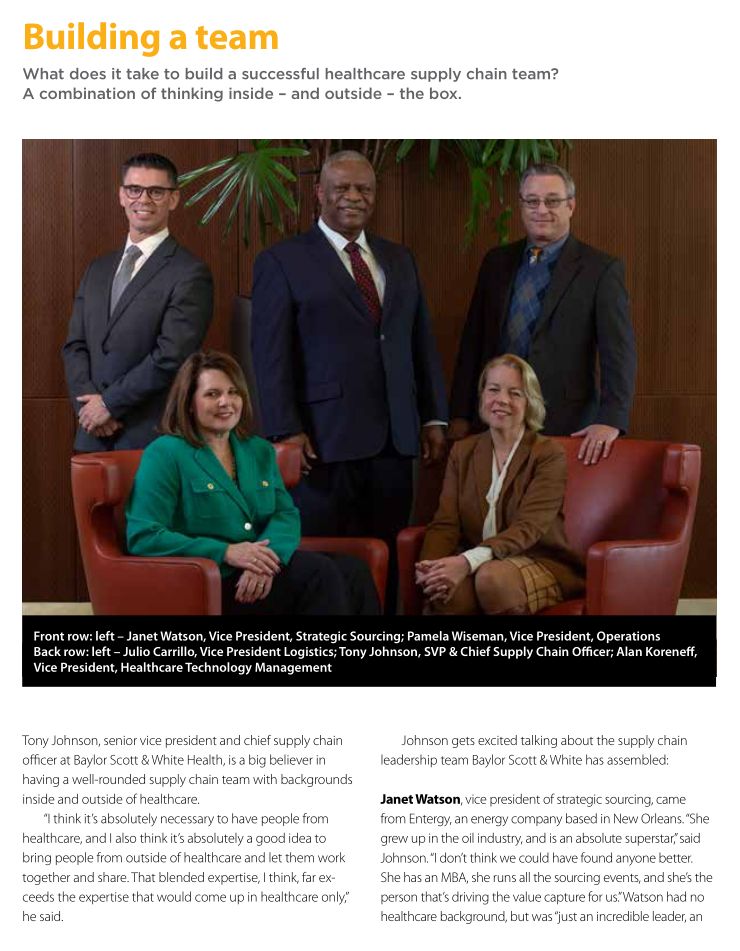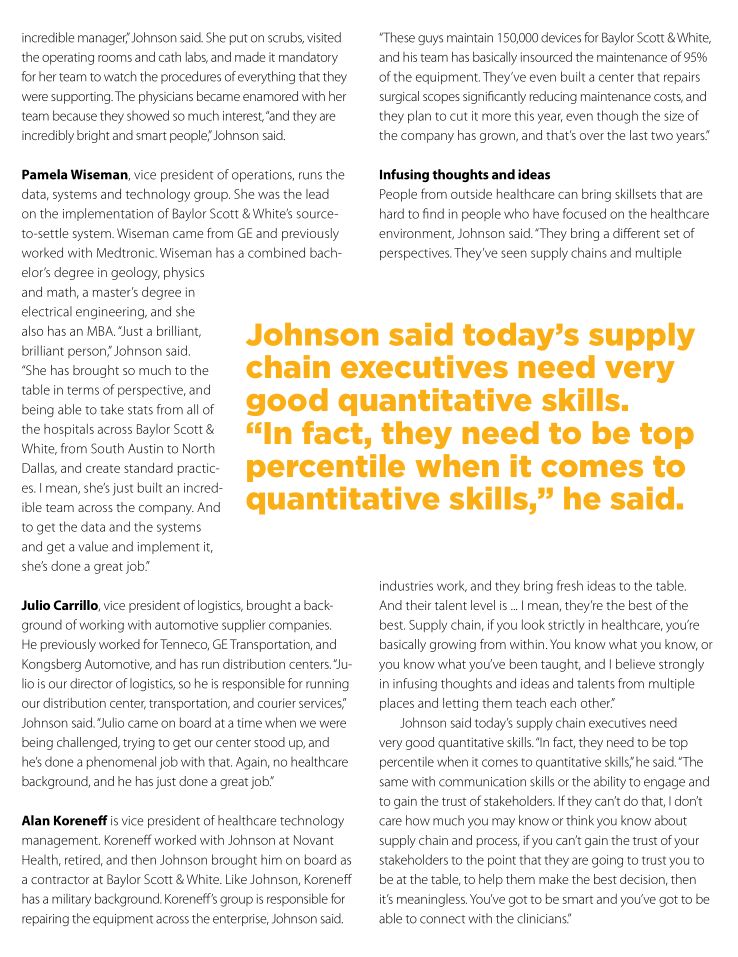How this year’s Contracting Professional of the Year led his organization’s supply chain through a transformation – and realized $92 million in value during the past fiscal year –by moving to a more strategic model
Tony Johnson has had the confidence to tackle big projects since early in his career. He credits the U.S. military for giving him that confidence.
Johnson specialized in healthcare supply chain in the military. While being a supply chain leader in a military hospi-tal was not much different than being a leader or manager in a commercial hospi-tal, the difference was the mission and the scale of the military, he said.
“We always had that underlying mis-sion: Protecting our forces around the globe and being able to support them in any place, any time. The military is designed to basically move an entire ware-house from point A to point B, set it up and have it operational within a couple of days if it has to,” Johnson said.
The systems, transportation links, pieces and sheer mass involved with military operations forced you to think bigger, he said, “and, because you’re so used to dealing with so much scale, it takes away the fear of doing something that you haven’t done before.”
Military personnel are given the op-portunity to do some extraordinary things, Johnson said, “so I think it gives you the confidence to feel that you could take bold steps and you’re going to be okay.”
For instance, in 1994 immediately after the Rwandan genocide, Johnson was sent to Entebbe, Uganda, as the senior healthcare logistics officer on a Depart-ment of Defense joint task force. He was given a laptop and an Inmarsat satellite communications dish to connect with the medical logistics hub in Europe and the national inventory control point in Pennsylvania. His mission was to set up a system to pull supplies into central Africa and distribute them to refugee camps in Rwanda, Tanzania, Democratic Republic of the Congo, Kenya and Uganda. As the senior healthcare supply chain person in the conflict region, he found himself sup-porting the U.S. Department of Defense, U.S. Department of State, the Centers for Disease Control and Prevention, the United Nations High Commissioner for Refugees and several non-governmental organizations like Doctors Without Borders. Johnson and a 12-person medi-cal logistics team planned the shipment of approximately 40 tons of medical supplies, pharmaceuticals and equipment into Uganda and executed the shipment and delivery of those supplies to multiple countries and organizations from Uganda.
“We did this with no process manual or instructions,” he said. “You must be ready to leverage your training, think through any objective, develop plans and execute. And of course, we learned very early that transportation, when it comes to pure logistics, is always the Achilles heel. You have to figure out how you’re going to get the stuff there.” Johnson has used that and similar experiences to build a successful career in healthcare supply chain, including in his current role as senior vice president and chief supply chain officer at Baylor Scott & White Health. Johnson is this year’s Contracting Professional of the Year.
From transactional to strategic
When Johnson first arrived at Baylor Scott & White in 2016, he took some time to observe how the organization operated before implementing changes. What he noticed was that the integrated delivery network’s supply chain was designed to process orders. Purchasing and payment decisions were made at the hospital level.
“That’s what we were staffed for and that’s what we did,” said Johnson.
As a result, the organization was pay-ing two to three times more for the same product from one hospital to the next. There was no consistency, Johnson said.
“Vendors were charging each one based on negotiations at that individual hospital,” he said. “We saw that across the board. Not only did it cost us, but it increased the numbers of contracts expo-nentially when you had to have a contract for every facility with different terms and conditions and different pricing.”
To move toward a more strategic model, the supply chain team took a step back to evaluate its marketplace position as well as how it made decisions on supplies.
“We should take the $1 billion of spend that we have and make corporate decisions rather than hospital decisions on everything,” Johnson said. Johnson said Baylor Scott & White faced several challenges implementing the new model. The first was cultural.
“When you have an organization as large as this, with a lot of prestigious physicians on staff, if it’s not approached in the right way, people may think that you are taking an administrative func-tion and basically telling the clinical side what they should do or how they should practice. That was not the intent at all. It was getting the culture to take a step back and decide what it wanted to do as an enterprise. And then delivering the results,” Johnson said.
The second challenge was having the right talent.
“It takes a very different type of talent to process transactions than it does to mine through millions of transactions, discover what you’re doing, benchmark, understand where the market is, come up with a strat-egy, get alignment with the stakeholders, build teams that are led by the stakeholders, have targets that are achievable but aggres-sive targets, and then actually deliver,” he said. To ensure the right talent, Johnson recruited seasoned supply chain executives and leaders from different industries.
Data, too, posed a problem. “The data was there but being able to do something with it was problematic, so we had to work through that,” Johnson said.
Source-to-settle
One concept that helped Baylor Scott & White’s supply chain team implement the new strategic model was a source-to-settle system. Johnson said he looks at source-to-settle as a work environment or an ecosystem where all processes are integrated and that uses the same set of data for everything related to:
- Analyzing
- Purchasing
- Planning and executing strategic sourcing events
- Writing, storing and managing contracts
- Ordering products from the contracts
- Receiving and invoicing
- Instructing the ERP to pay the bills
“That puts our operation on steroids in a sense, that we can see what we’re doing real-time,” he said. “It’s more of a point and click or web-based kind of environ-ment. It unleashes the power of research at the fingertips of the users versus having to send a query over to the report writing team for something very detail specific … and hoping that they can figure out a way to get your information back. So this basically pairs down the research and the decision-making capability, and puts every-thing at your fingertips.”
Before source-to-settle, the supply chain team “didn’t even have a clue as to how many contracts we had,” Johnson said. “Today, the first thing I see when I log on, is how many active contracts we have and how many of them are expiring within the next 120 days. That’s on the top of my screen. There’s a shopping cart, graphs and analytics. There’s a panel with my to-do list. Now, there are still things that I need to approve or take a look at. But all of those things were disjointed coming from different systems before. Now it’s all tied together.”
Improvements
While technology played a critical role bringing in $92 million in value to the organization, so did interpersonal dy-namics. The team created a commodity management process where MBA-level team members analyzed purchases like orthopedic or cardiac products.
“So, we analyzed our spending across the board, we selected what programs that we were going to go after for that year, and we presented that to our senior-level leadership. They bought into it,” Johnson said.
The team connected with the service line leaders for each area. The supply chain provided a very detailed, fact-based report with what they had been doing in the past, where they saw benchmarks, and where there was variation.
While the supply chain team would present the data to the service lines, it was the service lines that would lead and make the decision, Johnson said.
“We would be there as the facilitators to keep the process moving and bring-ing more data when they needed it. Of course, we were not short of opinions on the process. We gave them a program with opportunity that we could go after as an enterprise. They were very successful in doing that,” he said.
People didn’t feel they were in turf fights, Johnson said, “and the very highest levels of the organization, our C-suite executives were involved in some of these discussions. They really pushed us across the board to do the right thing. We creat-ed a very programmatic way of analyzing our spend, identifying opportunity, build-ing the teams to go after that opportunity, developing an enterprise-wide strategy, and then going into the market as a single entity of Baylor Scott & White.”
Part of that value involves using supply expense as a percentage of net patient revenue as a key indicator. The supply chain team wanted to find some-thing measurable through the financials that would indicate that something good was happening or recognize that nothing was happening.
“I think historically, you see a lot of supply chains saying, ‘I saved this or I saved that’ and they put some astronomi-cal numbers up, but when you look at the financials, it all looks the same or it’s just random noise in the financials,” Johnson said. “We’re actually held accountable to lowering that number. And for us, every half a percentage point we lower that num-ber, it’s $32 million of cost permanently taken out of the system. We’ve lowered at approximately 2 percentage points already.”
When looking at the company finan-cials for the last eight years, Johnson said he could see a noticeable change in 2018.
“Now, when you look at the financials, the supply line has all sorts of things in it that we’re not accountable for, but even then you see that number start to move south in 2018, when we launched this process,” he said.
Gaining more visibility Johnson said the next phase involves creating dashboards so that every user in Baylor Scott & White, and every administrator, will have access to these dashboards. The dashboards will give them data on their specific piece of the operation and what they need to do. “Healthcare, at least the healthcare systems I’ve been involved with … they will do accruals at the end of the year, but they basically book expenses when bills are paid. So, there’s a lag between that and when you have actually placed an order,” he said.
To illustrate, Johnson uses a check-book metaphor, where you write a check for a product, but when it clears the bank is when it actually shows up as an expense. “Well, we’re going to show the checks that have been written. We’re go-ing to show the things that have cleared the bank and we’re going to show thosethings that haven’t cleared the bank, that are waiting, so that every user has a look at those all the time and can make the ap-propriate decisions.”
Johnson said he expects to have that capability within six months. “The key to that, again, is the data. The very good data that we can now put together.” Baylor Scott & White is focused on clean, consistent and complete data and on business intelligence tools to unlock the power of data. Johnson expects many more improvements by unlocking information from millions of transac-tions each year.



